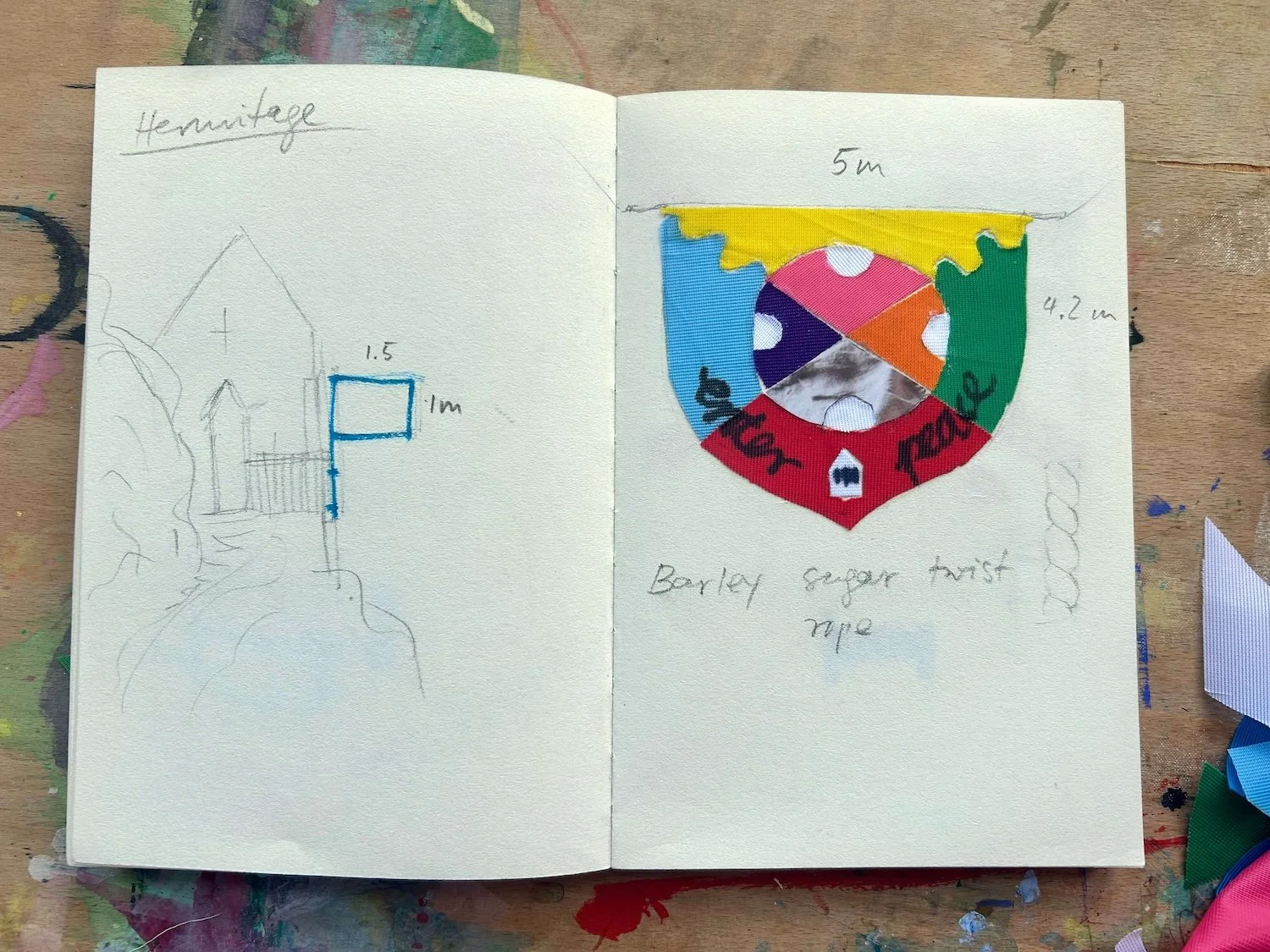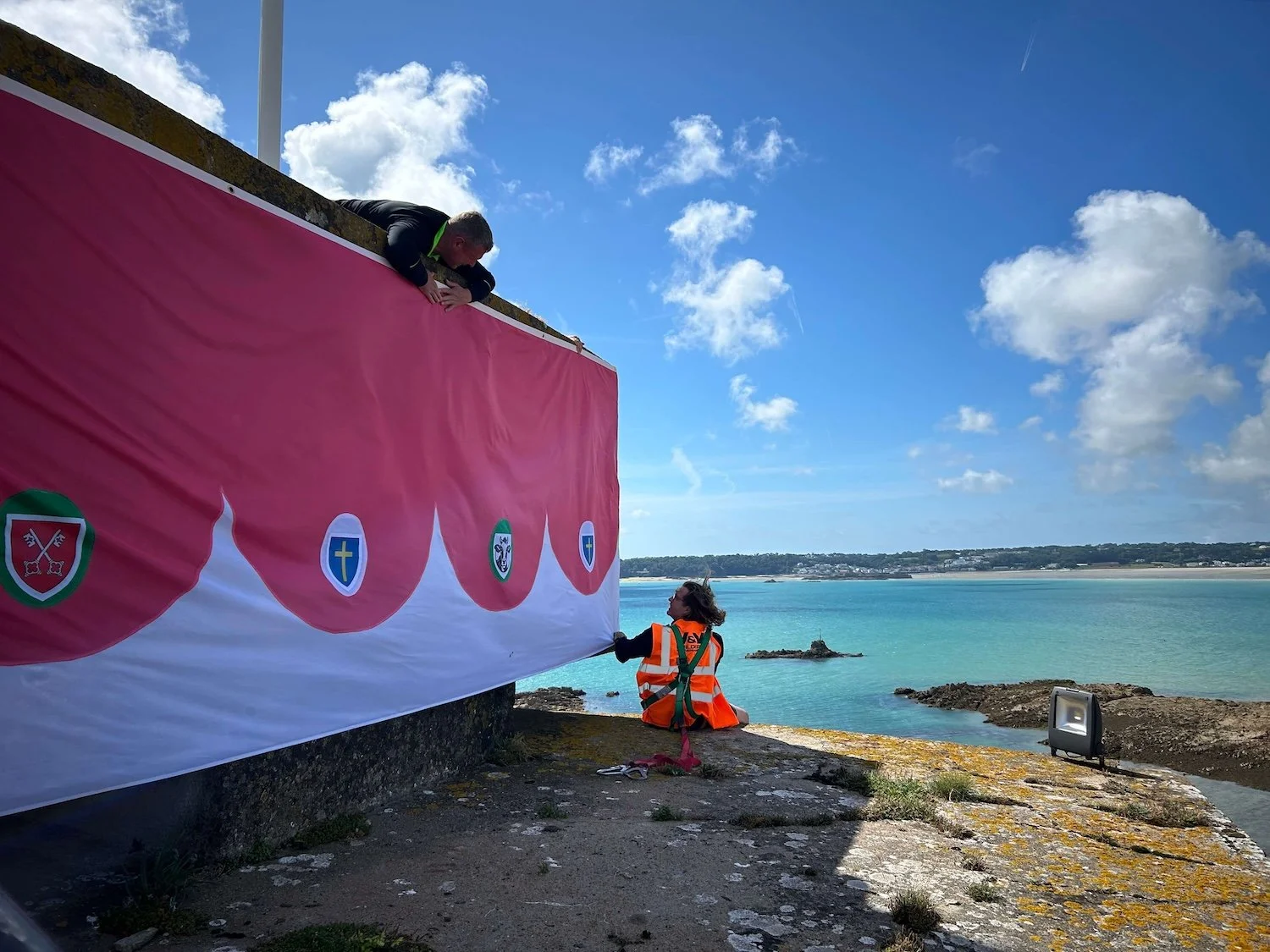BLOWING AGAINST THE WIND
I was commissioned to create a unique series of banners and flags to celebrate the rich and layered history of Jersey’s much-loved Elizabeth Castle. The aim was to bring to the fore its spiritual history by laying out a trail of flags for visitors to follow starting from the castle’s entrance and leading to the Hermitage where Saint Helier lived in 500AD. The installation invites people to follow a thread into the past, and to find their own path amidst the stories, symbols, myths, and histories that surround and give meaning to this place.
By dressing the castle, the inspiration for this project comes from and relates back to this iconic site. Blowing Against The Wind encourages engagement with heritage in new and thought-provoking ways by merging contemporary art with history.
Each flag disrupts the traditional idea of heraldic or national flags. Using curves, rather than geometric symmetry, and non-conforming colours, like hot pinks, they broaden our notion of flags and their function. Most of the banners are site-specific and respond directly to the architecture and history of the castle.
Commissioned by Jersey Heritage.
Produced by Creative Commissions
Producer Aras Amiri
Enter in Peace
The first banner of the trail right at the entrance of Elizabeth Castle sets the tone with a burst of colour and introduces the purpose of the flag trail into the spiritual past of the place.
The little house hints at the shape of the primordial human shelter, a roof over our heads, as well as at the final destination of the installation, the bed of Saint Helier. An intimate and personal place.
Nazi Bunker Skirt
During the German Occupation 1940-45 the Nazis put a concrete bunker on top of Elizabeth Castle. I wanted to resist this dominating gesture and had the idea to put a pink skirt around the bunker as an act of reclamation. The scallops of the skirt are decorated with Jersey parish crests, cows, potatoes and cabbages. The 30 meters long ‘tutu’ is visible for miles from land and sea and transforms the bunker into a joyful landmark for Jersey.
Abbey Square Twins
After St. Helier’s death a monastic community formed on the islet and at some point a big Abbey church existed there. Over the decades it got used as a gun powder storage and eventually got hit by a missile and exploded. Not one brick of it is left.
The twin banners mirror the architecture they sit on and hint at this lost piece of history by renaming the parade place into Abbey Square. Their shapes refer to Jersey cows and their significance in the island’s economy
Windmill
In the 17th century there was a fortified windmill on the island. It was destroyed during one of the many wars the castle has seen. This banner not only commemorates the lost windmill, but also the formal fluidity, the repeated house shape pattern, the use of green, white, and purple. Its shape with the red berry at the bottom, is evoking a sense of femininity, which further transforms the masculine history of a castle that is predominantly associated with war and weapons.
Sun Sail
A horizontal banner at the Iron Gate of the castle. It is a hidden location as viewers have to look up to discover it. At the heart of the banner is the motif of the house in purple. Sun Sail sings its colours in a nice sunny day, a reminder of light and its spiritual significance.
Gun Powder Chapel
This former gun powder storage called Sergeant Laniard’s Magazine is transformed into a chapel. A place for visitors to contemplate and reflect. The fire that had to be kept out has been brought back in. But this time it is the fire of love, devotion and passion.
Castle Wall
This banner sits prominently on one of the oldest walls of Elizabeth Castle and invites back references to bed sheets, and the little green house motif. It is a formal deconstruction of traditional national flags and as such makes their symbolism fluid and open again.
Hermitage - St. Helier’s Bed
Final destination of the flag trail.
This last flag marks the destination of the trail which is the hermitage itself. The flag is placed outside the little chapel with its triangular roof, showing symbols of beds and Jersey flag.
It is here where hermit Helibert, later known as Saint Helier lived in 500AD, the chapel sheltering a rock which was his bed.
He was beheaded by Viking pirates and myth has it that he carried his own head to the shore. The 12th century chapel erected over his bed lends the main symbol to the installation: the house, primordial symbol of human shelter and safety.

